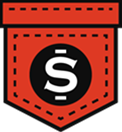The Low-Down on Iron Ons

Iron on transfers is a very cost effective technique of applying designs to t-shirts and other printable apparel. You won’t get the same quality of print as if you were to use screen printing or digital printing, but you can definitely produce commercially viable results. In fact, a lot of small t-shirt printing businesses start off with iron on heat transfers, and eventually upgrade to another technique as order volume increases. You don’t have to run a business to apply iron on transfers though. It’s so easy, anyone can do it.
Here’s what you need to get started:- Computer with graphic designing software (such as Photoshop or CorelDraw)
- Artwork (at least 300dpi, and should fit on an 8.5 x 11 sheet of paper)
- Heat transfer paper
- Laser or inkjet printer
- Clothing iron or heat transfer press
- Blank t-shirt
If you’re going to use an iron, you will also need:
- Hard surface to iron on (no ironing boards)
- Towel
The first thing you need to do is to flip your artwork horizontally in your designing software. When you print on the transfer paper, it needs to be a mirrored image of your design. This is especially important if you have text in your design. When you transfer the design to the t-shirt, everything will be flipped back to normal. So don’t forget this step. The last thing you want is backwards text on your t-shirt.
Make sure that you use right type of heat transfer paper. They are made specifically for laser or inkjet printers, so get one based on what type of printer you have. Using the wrong paper may end up damaging your printer, so be careful. Also, keep in mind what color t-shirts you want to apply designs to. Most transfer papers are made for white/light t-shirts. If you’re going to be using black/dark t-shirts, look for transfer paper that says they are for darker fabrics. Finally, if your transfer paper does not use some type of cool-peel backing paper, then you will need to peel off the paper immediately after applying the heat. Cool-peel transfer paper allows you to peel the backing off when t-shirt cools completely. This may be ideal if you don’t want to risk burning your fingertips after transferring the design.
It’s time to start printing and transferring your design. You may want to do a test print on the transfer paper, and apply the design to some scrap fabric of the same material. This will ensure your actual print comes out to your satisfaction, without having to waste a t-shirt. Once you have printed your design to the transfer paper, trim the sheet as close to the design as possible (within an eighth of an inch is preferable). The iron-on will sit on-top the fabric, and leaves a plastic-like feel where-ever there is transfer. If you don’t trim your design, then you’re going to end up with large plastic-like areas where there is unprinted design. This will leave your t-shirt looking very sloppy and unprofessional.
If you’re using a clothing iron, use the hottest heat setting with no steam. Always pre-heat the iron. Place the t-shirt on a hard surface. Do not use an ironing board as they are sometimes padded and will quickly disperse the heat, resulting in a patchy transfer job. Place the transfer paper on-top the t-shirt, and then cover the paper with a thin kitchen towel. Using both hands, apply heat to the towel using the iron in circular, overlapping motions. For a more professional job (especially if you’re printing commercially), use a heat transfer press. They will run you around $350 - $1000. An iron doesn’t provide enough pressure for high end prints (even with both hands). A heat transfer press will evenly apply a constant pressure to your t-shirt, ensuring consistent adhesion. This really helps the longevity of the transfer, and your t-shirt will survive many more washes than if you were to use an iron. It is also less labor intensive than an iron, so you will save more time.
So that’s it! If you follow all the directions above, you will be making commercial grade t-shirt prints in no time. Whether you’re making a few t-shirts for a bachelorette party, or fulfilling your customers’ orders, you’re bound to have people raising eyebrows at your handiwork.









